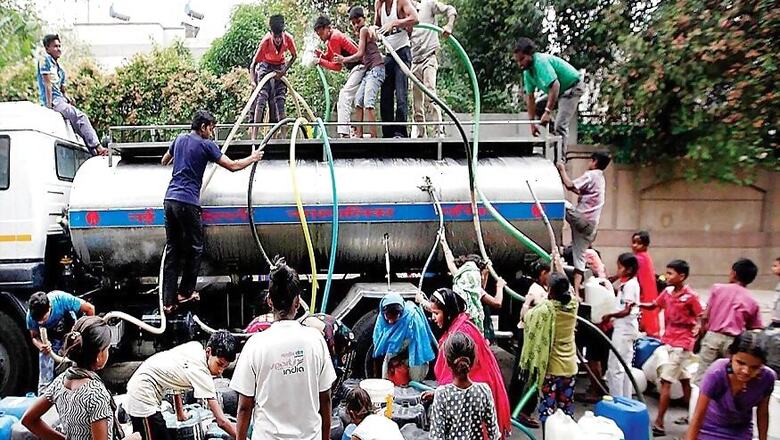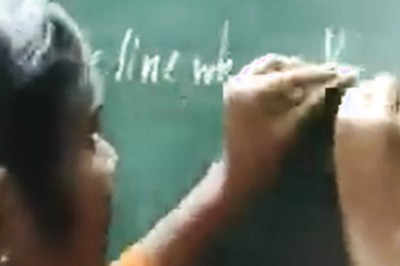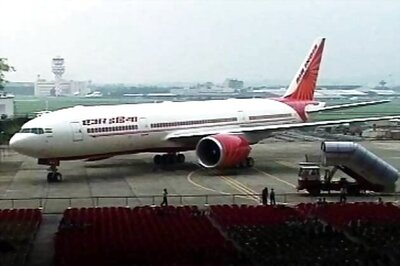
views
The worldwide spread of the coronavirus disease (Covid-19) highlights the intensity of global interconnections, and social and economic interdependence between regions. The pandemic has reinforced the critical need for access to safe and assured water supply for all, as described in the United Nations Sustainable Development Goals, for preventing rapid transmission of the disease.
The World Health Organization (WHO) and the Union Ministry of Health and Family Welfare have highlighted several steps including frequent handwashing with soap and water (or alcohol-based hand sanitiser) for individuals and frequent cleaning (sanitising) of private and public facilities as the first line of defence against the transmission of this disease.
More than 1,250 cases have been reported so far in the country and it is important to remember that India struggles with a host of water access and availability challenges which are likely to complicate government and community efforts to deal with this rapidly emerging pandemic.
Water availability
India ranks 13th out of 17 countries on the list of ‘extremely highly’ water-stressed countries in the world. Furthermore, over 85% of India’s domestic drinking water is sourced from underground aquifers but 17% of units (blocks/taluks) assessed by Central Ground Water Board are over-exploited, indicating withdrawal far outstrips recharge. Typical declining of surface and groundwater resources coupled with higher water demands during summer months add to this water stress.
Water sector experts estimate a five-person household will require around 100-200 litres of additional water per day just for handwashing, increasing daily demand by approximately 20-40 litres per capita per day (lpcd). For a city of about 10 million (Bengaluru, for example) this additional water burden can range between an extra 200-400 million litres of water per day that will need to be provided immediately and evenly across the population.
Water availability stress can potentially bring significant challenges in India’s immediate and continued effort of preventing the transmission of this disease at the community level. Among the many decisions that authorities are/will be taking to limit the spread of the pandemic, a critical one will be to devise a plan to reliably meet water demand during upcoming summer months.
Safe and timely access
While water availability is a concern, access to safe and assured water supply is another crucial challenge. Public water supply across Indian cities remains intermittent and piped water supply networks do not serve entire cities. There are two groups in urban India, at opposite ends of the income scale, who have inadequate access to piped and safe water supply. First are vulnerable, lower income communities living in informal settlements, and second are residents in gated communities in peri-urban regions.
Lower income and vulnerable communities have communal water and sanitation services where people gather in groups, increasing risk of local transmission of the disease. Furthermore, water is barely available for daily needs of cooking, bathing and hygiene; sourcing additional water for frequent handwashing will be a huge challenge for these households. It is recommended that households spend no more than 3-5% of average household income on water and sanitation services but having to procure additional water during this crisis can place a huge financial burden on these households.
Peri-urban regions in India have many townships and gated communities and host a large proportion of urban populations. These areas are typically unserved by public water utilities and depend on tanker water supply and/or groundwater to meet potable and non-potable water demand. The risk to such communities arises from the uncertainty attached with tanker water supply. Tanker water suppliers interact with multiple people and are at high risk to contract the disease, unless strictly practising preventive measures. This can potentially lead to interruption of critical water supply.
The lack of easy and continuous access to safe water has differing implications on these two types of urban residents. But in times of a global pandemic, lack of water renders everyone vulnerable.
The road ahead
During this crisis, water has emerged as a critical resource that can help limit the virus’s spread by enabling individuals to practise personal hygiene. But in India’s context there are concerns around water availability and supply service gaps which leave households, particularly in vulnerable communities, at high risk.
Residents of informal settlements are highly exposed to this virus and an outbreak there can be particularly devastating. The physical nature of these spaces reduces the effectiveness of social distancing and lack of water hinders efforts to maintain personal hygiene. Furthermore, even a few cases in these settlements can lead to rapid transmission within the area and eventually spread to a wider region. It is, therefore, critical to focus on mitigation efforts, especially directed at these groups, to ensure prevention.
The most urgent response from the water sector is to provide simple and effective mechanisms to provide safe and assured supply of water for all. Various cities in India have installed handwashing facilities with soap and water in public locations. Such installations should be rapidly scaled up in India to reach the most vulnerable users, particularly in informal settlements.
Financial impetus for these efforts can be provided by corporate social responsibility funds, which the government is allowing to be used to support Covid-19 response efforts. One design innovation that can be useful to reduce risk of transmission is the use of foot-pedal-operated taps, which does not require operating the tap by hand and is a low-energy system.
(Samrat Basak is the Director of WRI India's Urban Water Program and Sahana Goswami is a Manager for the Cities Program in WRI India. This blog was first published on WRI-India.org. Views expressed are personal.)



















Comments
0 comment